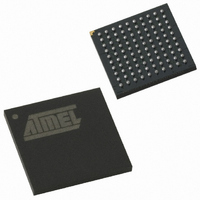AT89C51SND2C-7FTUL Atmel, AT89C51SND2C-7FTUL Datasheet - Page 168

AT89C51SND2C-7FTUL
Manufacturer Part Number
AT89C51SND2C-7FTUL
Description
IC 8051 MCU FLASH 64K MP3 100BGA
Manufacturer
Atmel
Series
89Cr
Datasheet
1.AT89C51SND2C-7FTUL.pdf
(242 pages)
Specifications of AT89C51SND2C-7FTUL
Core Processor
8051
Core Size
8-Bit
Speed
40MHz
Connectivity
I²C, IDE/ATAPI, MMC, SPI, UART/USART, USB
Peripherals
Audio, I²S, MP3, PCM, POR, WDT
Number Of I /o
32
Program Memory Size
64KB (64K x 8)
Program Memory Type
FLASH
Ram Size
2.25K x 8
Voltage - Supply (vcc/vdd)
2.7 V ~ 3.3 V
Data Converters
A/D 2x10b; D/A 2x20b
Oscillator Type
Internal
Operating Temperature
-40°C ~ 85°C
Package / Case
100-TFBGA
Data Bus Width
8 bit
Data Ram Size
2.25 KB
Interface Type
ATAPI, I2S, IDE, SPI, UART, USB
Maximum Clock Frequency
40 MHz
Number Of Programmable I/os
32
Number Of Timers
2
Maximum Operating Temperature
+ 85 C
Mounting Style
SMD/SMT
Minimum Operating Temperature
- 40 C
Lead Free Status / RoHS Status
Lead free / RoHS Compliant
Eeprom Size
-
Lead Free Status / Rohs Status
Details
Other names
AT89C51SND2C7FTUL
Available stocks
Company
Part Number
Manufacturer
Quantity
Price
Company:
Part Number:
AT89C51SND2C-7FTUL
Manufacturer:
ATMEL
Quantity:
4 371
- Current page: 168 of 242
- Download datasheet (3Mb)
20. Serial I/O Port
20.1
20.2
20.2.1
168
Mode Selection
Baud Rate Generator
AT8xC51SND2C/MP3B
Timer 1
The serial I/O port in the AT8xC51SND2C provides both synchronous and asynchronous com-
munication modes. It operates as a Synchronous Receiver and Transmitter in one single mode
(Mode 0) and operates as an Universal Asynchronous Receiver and Transmitter (UART) in three
full-duplex modes (Modes 1, 2 and 3). Asynchronous modes support framing error detection and
multiprocessor communication with automatic address recognition.
SM0 and SM1 bits in SCON register (see Figure 20-3) are used to select a mode among the sin-
gle synchronous and the three asynchronous modes according to
Table 20-1.
Depending on the mode and the source selection, the baud rate can be generated from either
the Timer 1 or the Internal Baud Rate Generator. The Timer 1 can be used in Modes 1 and 3
while the Internal Baud Rate Generator can be used in Modes 0, 1
and 3.
The addition of the Internal Baud Rate Generator allows freeing of the Timer 1 for other pur-
poses in the application. It is highly recommended to use the Internal Baud Rate Generator as it
allows higher and more accurate baud rates than Timer 1.
Baud rate formulas depend on the modes selected and are given in the following mode sections.
When using Timer 1, the Baud Rate is derived from the overflow of the timer. As shown in
Figure 20-1 Timer 1 is used in its 8-bit auto-reload mode (detailed in Section "Mode 2 (8-bit
Timer with Auto-Reload)", page 54). SMOD1 bit in PCON register allows doubling of the gener-
ated baud rate.
SM0
0
0
1
1
SM1
0
1
0
1
Serial I/O Port Mode Selection
Mode
0
1
2
3
Description
Synchronous Shift Register
8-bit UART
9-bit UART
9-bit UART
Baud Rate
Fixed/Variable
Variable
Fixed
Variable
Table
20-1.
4341H–MP3–10/07
Related parts for AT89C51SND2C-7FTUL
Image
Part Number
Description
Manufacturer
Datasheet
Request
R

Part Number:
Description:
DEV KIT FOR AVR/AVR32
Manufacturer:
Atmel
Datasheet:

Part Number:
Description:
INTERVAL AND WIPE/WASH WIPER CONTROL IC WITH DELAY
Manufacturer:
ATMEL Corporation
Datasheet:

Part Number:
Description:
Low-Voltage Voice-Switched IC for Hands-Free Operation
Manufacturer:
ATMEL Corporation
Datasheet:

Part Number:
Description:
MONOLITHIC INTEGRATED FEATUREPHONE CIRCUIT
Manufacturer:
ATMEL Corporation
Datasheet:

Part Number:
Description:
AM-FM Receiver IC U4255BM-M
Manufacturer:
ATMEL Corporation
Datasheet:

Part Number:
Description:
Monolithic Integrated Feature Phone Circuit
Manufacturer:
ATMEL Corporation
Datasheet:

Part Number:
Description:
Multistandard Video-IF and Quasi Parallel Sound Processing
Manufacturer:
ATMEL Corporation
Datasheet:

Part Number:
Description:
High-performance EE PLD
Manufacturer:
ATMEL Corporation
Datasheet:

Part Number:
Description:
8-bit Flash Microcontroller
Manufacturer:
ATMEL Corporation
Datasheet:

Part Number:
Description:
2-Wire Serial EEPROM
Manufacturer:
ATMEL Corporation
Datasheet:











